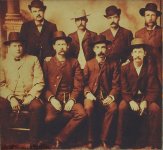Old Hollywood and Real life
Hi:
I have started to take notice on Western Movies (new and old) that westerners (cowboys) carried "Cross Draw" instead of the "Hollywood Fast Draw" type holster ?
As noted by the other posters___Hollywood just wasn't the way it was. Some recent westerns have been closer to being authentic in dress and the way pistols were carried. And__as one noted the walking down Main Street and fast drawing and firing just didn't happen.
The cross draw is still a comfortable carry method and easy to use when driving, sleeping in a sleeping bag or walking in the forest.
I recently saw one film where the detective actually carried an ivory handled 1911 in a cross draw. It wasn't "concealed".
Detectives are policemen, not under cover operations. We not only carried a pistol but handcuffs, a couple extra magazines and a smallish flashlight. One clothing store in town did accommodate us
by allowing a next size up for our suit coats off the rack__then tailored them for us__no extra charge. That still didn't "conceal"
everything.
Actually the F.B.I. cant seemed more to keep the pistol sort of hidden when the agents were talking to someone in their home,
I think so not to "offend". Its not a real good way to pack since drawing puts strain on wrist, elbow and shoulder.
As a working detective I found cross draw more comfortable__Both 1911 and a S&W Model 39.
Today I use appendix carry (Wasn't any such holsters back then)
and a Comp-Tac Neutral Gladiator, a N82 Pro (Summer/ T-shirt
and shorts and a Sticky__all at the appendix carry.
I agree with the other posters about most of the cowboys were't gunman__but most deadly with a rifle.
In the archives about one of the shoot outs in a Kansas cowtown
(saloons were smaller than Hollywood shows them, usual) there was like sixty shots fired between two trail outfits. The only casualty was the cat that normally was asleep on the piano.
A lot of the well known outlaws carried lead in several areas of their bodies. I've often thought "very old ammo" maybe didn't penetrate well?
G'luck and carry what's comfortable for you.



